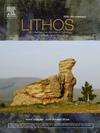The magma source of the rare earth element-mineralized carbonatite–syenite complexes in the Oligocene Mianning–Dechang belt, western Sichuan, Southwest China
IF 2.9
2区 地球科学
Q2 GEOCHEMISTRY & GEOPHYSICS
引用次数: 0
Abstract
Carbonatite–syenite complexes contain over half of the rare earth element (REE) resources worldwide, particularly the light REEs. These deposits are thought to be mainly sourced from REE-enriched subcontinental lithospheric mantle (SCLM). However, the precise nature of the mantle source is debated due to ambiguous interpretations of Sr–Nd–Pb isotope and trace element data. Four Oligocene REE deposits in the Mianning–Dechang (MD) REE belt in Sichuan Province, China (Maoniuping, Lizhuang, Muluozhai, and Dalucao) are ideal for investigating the magma sources in such deposits. These deposits have well-documented geological features and previously published Li–B–Sr–Nd–Pb isotope data, and contain fresh zircons in syenite (nordmarkites) formed by immiscibility from the carbonatites. Despite the abundant Sr![]() Nd isotope data, distinguishing between metasomatic contributions from the upper continental crust and marine sediments is challenging. To address this, we present zircon Hf
Nd isotope data, distinguishing between metasomatic contributions from the upper continental crust and marine sediments is challenging. To address this, we present zircon Hf![]() O isotope data for the MD REE belt, obtained by laser ablation–multi-collector–inductively coupled plasma–mass spectrometry (LA-ICP-MS) and secondary ion mass spectrometry, respectively. We use these data to trace the origins of the REE-enriched magmas. Given the complex geological history of this region, including ca. 260 Myr of subduction, we tested a multi-end-member magma source model that includes depleted mid-ocean ridge basalt mantle (DMM), high- and low-temperature altered oceanic crust (AOC), and marine sediments. Using a Monte Carlo simulation for this multi-end-member mixing, coupled with the longest increasing subsequence algorithm, we modeled the time-dependent contributions of these components during Proto-Tethyan oceanic subduction beneath the Yangtze Craton. Our results suggest that, by the end of subduction, marine sediments contributed approximately 13 %, 24 %, 25 %, and 22 % among these three endmembers to the magma sources of the Maoniuping, Dalucao, Lizhuang, and Muluozhai deposits, respectively. The DMM and AOC were the main components in the source. Although marine sediments that are enriched in REEs relative to DMM and AOC contributed significantly to the REE contents of the lithospheric mantle, our findings indicate that the scale of the REE deposits was not solely controlled by the incorporation of marine sediments. The results indicate the need for a reassessment of the role of marine sediments in the petrogenesis of carbonatite magma and formation of REE deposits.
O isotope data for the MD REE belt, obtained by laser ablation–multi-collector–inductively coupled plasma–mass spectrometry (LA-ICP-MS) and secondary ion mass spectrometry, respectively. We use these data to trace the origins of the REE-enriched magmas. Given the complex geological history of this region, including ca. 260 Myr of subduction, we tested a multi-end-member magma source model that includes depleted mid-ocean ridge basalt mantle (DMM), high- and low-temperature altered oceanic crust (AOC), and marine sediments. Using a Monte Carlo simulation for this multi-end-member mixing, coupled with the longest increasing subsequence algorithm, we modeled the time-dependent contributions of these components during Proto-Tethyan oceanic subduction beneath the Yangtze Craton. Our results suggest that, by the end of subduction, marine sediments contributed approximately 13 %, 24 %, 25 %, and 22 % among these three endmembers to the magma sources of the Maoniuping, Dalucao, Lizhuang, and Muluozhai deposits, respectively. The DMM and AOC were the main components in the source. Although marine sediments that are enriched in REEs relative to DMM and AOC contributed significantly to the REE contents of the lithospheric mantle, our findings indicate that the scale of the REE deposits was not solely controlled by the incorporation of marine sediments. The results indicate the need for a reassessment of the role of marine sediments in the petrogenesis of carbonatite magma and formation of REE deposits.
川西渐新统冕宁-德昌带稀土元素矿化碳酸岩-正长岩杂岩岩浆来源
碳酸岩-正长岩杂岩的稀土资源占全球稀土资源的一半以上,其中以轻稀土最为突出。这些矿床被认为主要来源于富含稀土元素的次大陆岩石圈地幔(SCLM)。然而,由于对Sr-Nd-Pb同位素和微量元素数据的模糊解释,地幔源的确切性质存在争议。四川勉宁—德昌(MD)稀土带的4个渐新统稀土矿床(毛牛坪、李庄、木罗寨和大芦漕)是研究该类矿床岩浆源的理想场所。这些矿床具有良好的地质特征和先前公布的Li-B-Sr-Nd-Pb同位素数据,并且在碳酸盐岩不混溶形成的正长岩(北斑岩)中含有新鲜的锆石。尽管有丰富的SrNd同位素数据,区分来自上大陆地壳和海洋沉积物的交代贡献是具有挑战性的。为了解决这个问题,我们分别用激光烧蚀-多收集器-电感耦合等离子体质谱(LA-ICP-MS)和二次离子质谱法获得了MD REE带的锆石HfO同位素数据。我们利用这些数据来追踪富含稀土元素的岩浆的起源。考虑到该地区复杂的地质历史,包括约260 Myr的俯冲,我们测试了一个多端元岩浆源模型,包括枯竭的洋中脊玄武岩地幔(DMM),高低温蚀变海洋地壳(AOC)和海洋沉积物。利用蒙特卡罗模拟方法,结合最长增加子序列算法,模拟了这些组分在扬子克拉通下原特提斯洋俯冲过程中的时间依赖贡献。研究结果表明,到俯冲末期,海相沉积物对毛牛坪、大芦漕、李庄和木罗寨三段岩浆源的贡献率分别约为13%、24%、25%和22%。DMM和AOC是源的主要成分。尽管相对于DMM和AOC富集稀土元素的海相沉积物对岩石圈地幔的稀土元素含量有显著贡献,但我们的研究结果表明,岩石圈地幔的稀土矿床规模并不完全受海相沉积物的掺入控制。结果表明,有必要重新评价海相沉积物在碳酸盐岩岩浆成因和稀土矿床形成中的作用。
本文章由计算机程序翻译,如有差异,请以英文原文为准。
求助全文
约1分钟内获得全文
求助全文
来源期刊

Lithos
地学-地球化学与地球物理
CiteScore
6.80
自引率
11.40%
发文量
286
审稿时长
3.5 months
期刊介绍:
Lithos publishes original research papers on the petrology, geochemistry and petrogenesis of igneous and metamorphic rocks. Papers on mineralogy/mineral physics related to petrology and petrogenetic problems are also welcomed.
 求助内容:
求助内容: 应助结果提醒方式:
应助结果提醒方式:


